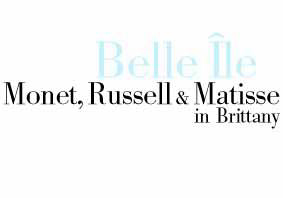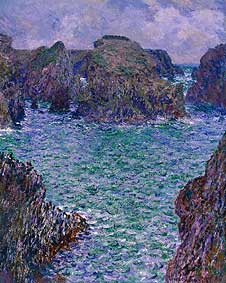Belle-Ile

|

|
This exhibition brings together works by Claude Monet, Henri Matisse and the Australian Impressionist John Peter Russell, who all painted on the storm-tossed island of Belle-�le, off the coast of Brittany in north-western France.
Belle-�le, the largest of the Breton islands, was the last landfall for European ships crossing the Atlantic to the New World of the Americas. Its hardy Celtic people had in turn repelled Caesar�s legions, waves of marauding corsairs and attacking English troops. Today, its population of 4,000 predominantly survive on tourism and fishing. The natural beauty of the island is dominated by its spectacularly rocky and dangerous coastline, carved by wind and water.
Painters first came to Belle-�le in the 19th century, lured by its remoteness, the picturesque survival of a colourful way of life and the freedom and emptiness of its ocean panoramas.
In 1886 the Sydney-born art student John Russell re-visited Belle-�le � having first discovered the island in 1883. Independently wealthy since inheriting a family fortune at the age of 21, Russell was passionate about art. He had been on the island, sketching and sailing the whole summer when he chanced upon a new arrival, painting on the windy cliff. Recognising Monet�s style, Russell asked him: �Ne seriez vous Claude Monet, le prince des impressionists?� (aren�t you Claude Monet, prince of the impressionists?). Flattered and amused by this approach, Monet allowed the young artist to paint with him, and thus had a decisive influence on the development of Russell�s work.
Within two years Russell had changed his life. Leaving Paris behind he became the first non-native to settle on the island. Building a large manor house the islanders called �Le Chateau de l�Anglais�, Russell began to realise his dream of founding a summer artists� colony. His studio overlooking the wild coast welcomed a stream of visitors including the great French sculptor Auguste Rodin and his assistant, the Australian painter John Longstaff, and the young Henri Matisse who became Russell�s friend and �pupil� over the two summers of 1896/97.
The first time Rodin saw the ocean off the Brittany coast he exclaimed: �It�s a Monet�. Monet�s remarkable series of paintings of the rocks and see at Belle-�le astounded the Paris art-world when he first showed them in 1887.
Inspired by Monet�s example, Russell declared to a fellow Australian artist that he now felt himself part of �a mighty revolution in art� because �impressionism as understood here consists not of hasty sketches but in finished work in which the purity of colour and intention is kept�. The breakthrough for Russell also came at Belle-�le where he painted many of the same motifs that Monet depicted, also in pure colours, under different weather conditions and at different time of the day.
It was subsequently, under Russell�s influence, that Matisse adopted the impressionist palette and made a series of paintings of rocks and sea that were like a homage to Monet�s work of a decade earlier.
�They all wanted to be alone with nature at Belle-�le,� said Ursula Prunster of the Art Gallery of New South Wales and Curator of this exhibition. �In Paris, Monet said, �one is too much taken up with what one sees and hears�. In this remote corner of France, each hoped to work uncontaminated by outside influences, to create an original vision of the savagely beautiful landscape. The irony was that they met each other at all � so far from Paris � and that their encounters proved so unexpectedly important for art history.�
The exhibition brings together more than 40 paintings by these key protagonists of French impressionism. The works are on loan from private and institutional collections in France, Japan, England, South America, the USA and Australia.
Art After Hours
on Wednesday evenings through January, from 2 January, until 9pm
Special admission charges apply and include viewing of Buddha
Exhibition Tour
Queensland Art Gallery
14 February to 21 April 2002
|
| On view: | Art Gallery of New South Wales
Art Gallery Road
The Domain, Sydney 2000 | | Telephone: | (02) 9225 1744 or recorded information
(02) 9225 1790
| | Hours: | 10am to 5pm 7 days a week
(closed Christmas Day and Easter Friday) | | Admission: | $8 adults / $5 members/students/concessions | | Media Information and Interviews: | Jan Batten
Press Office
telephone 61 2 9233 1213
email janb@ag.nsw.gov.au | Claude Monet Port-Goulphar, Belle Ile 1887 oil on canvas Collection Art Gallery of New South Wales Purchased 1949
|
|